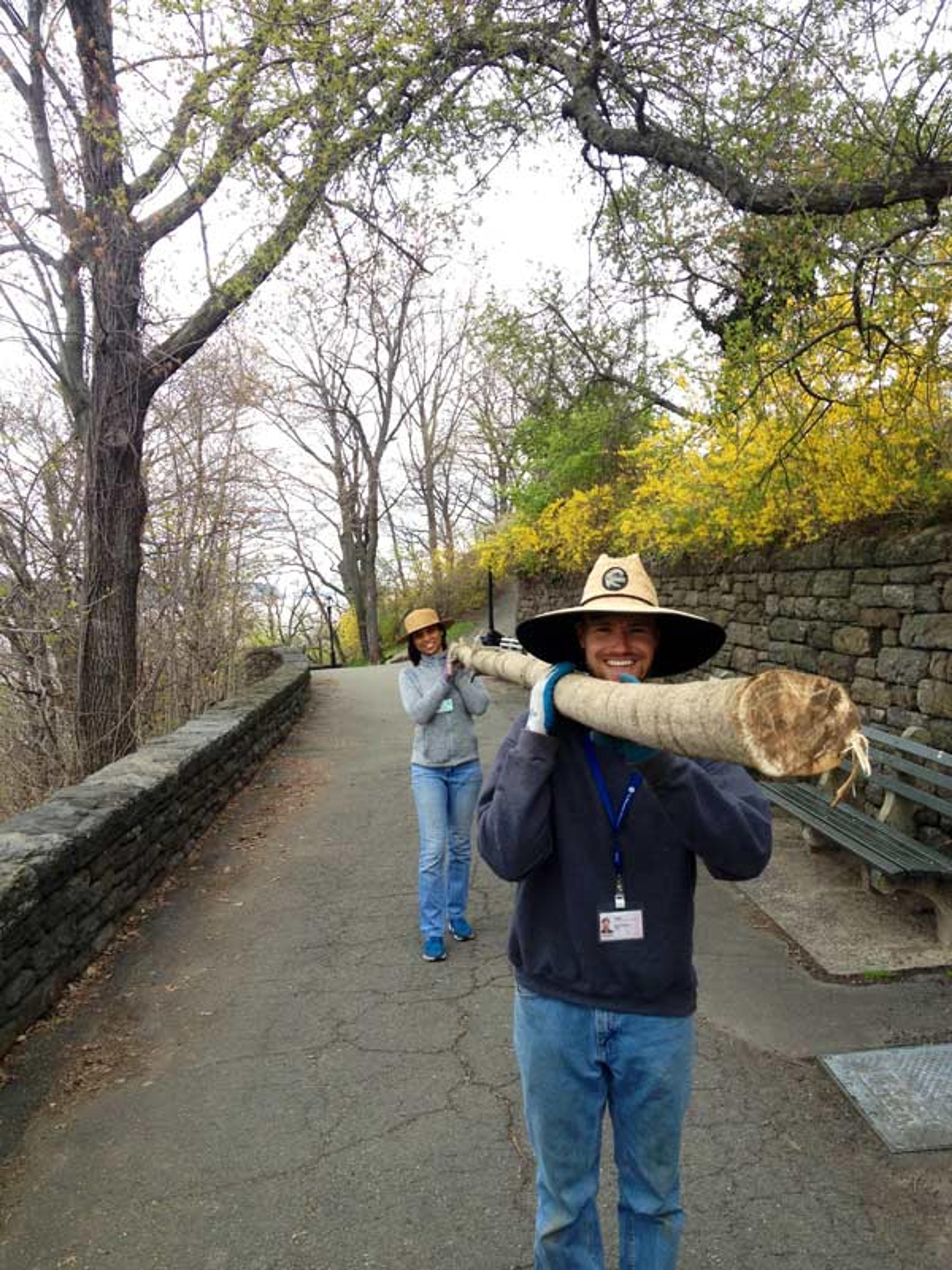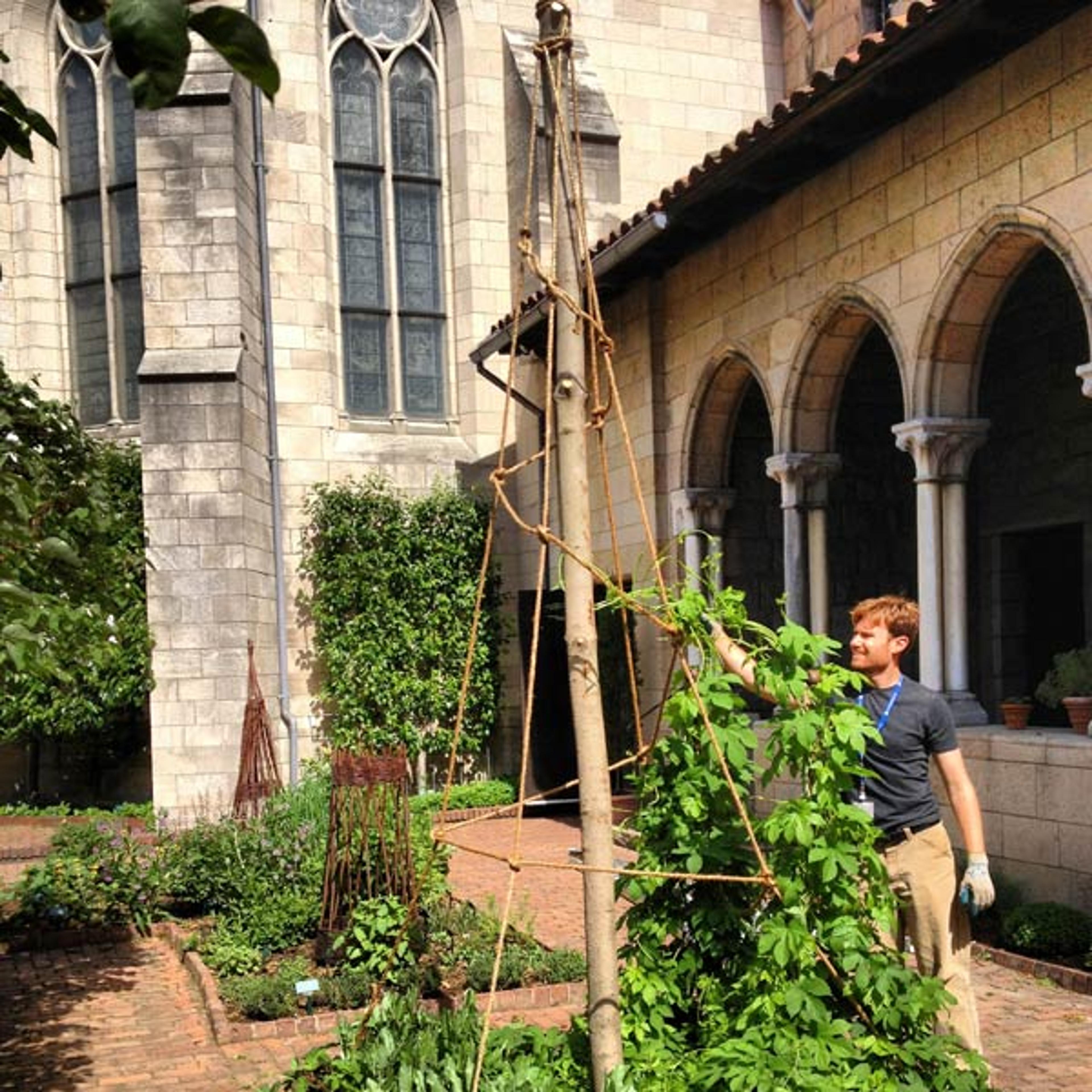A Perfect Platform, Part One: Building in Bonnefont

Gardeners Yvette Weaver and Bryan Stevenson transport a pole to The Cloisters museum and gardens. Photo by Caleb Leech
«Earlier this season, we decided to freshen up and expand the cultivated hops (Humulus lupulus) at The Cloisters museum and gardens. Managing Horticulturist Caleb Leech, Gardener Yvette Weaver, and I sought to construct a new structure on which to train the hops in the Bonnefont Herb Garden to grow, and to install a new bed in the grounds outside the Museum's walls for additional hops cultivation. We will share the process for accomplishing both projects over two blog posts. Today I will discuss how the gardens department went about constructing the new hops trellis in the Bonnefont Herb Garden, and the story of the new hops bed will be explained in a later post.»
In the past, gardeners at The Cloisters trained the hops plants to grow from the beer-brewing bed of the Bonnefont Herb Garden to the roof of the Bonnefont Cloister, which resulted in the hops being suspended, almost like a curtain, over the pathway below (see "Fall Garden Day" on The Medieval Garden Enclosed). The plan this year was to create a vertical trellis, similar to a circus tent, for the hops to grow on, which would restrict the hops' lateral growth to the brewing bed. This would serve not only to keep nearby areas and pathways clean and clear, but would also be in keeping with late medieval and early modern horticultural practices.
A woodcut from Reginald Scot's 1578 book A Perfite Platforme of a Hoppe Garden, and Necessarie Instructions for the Making and Mayntenaunce Thereof illustrates that cultivators of hops in the late medieval and early modern periods trained their hops plants vertically onto upright poles. For Scot, the ideal garden bed for hops is mounded like a small hill, with hops poles planted vertically and firmly at the top of the mound for the hops plants to climb. This creates small, discrete areas of cultivation, optimizing limited space and making the harvest of the hops flowers easier. We took a page from Reginald Scot's book in creating a vertical trellis for the hops in the Bonnefont Herb Garden.

The first step in constructing our new hops trellises was to obtain two tall, straight poles to serve as the foundation for the structure. With the approval of the New York City Department of Parks and Recreation, we ventured into Fort Tryon Park to harvest two highly invasive trees for use in constructing the trellises. Since removal of invasive species is part of what the Parks Department does, they were only too happy for us to harvest these two trees. After chopping the trees down and limbing them (removing the limbs and branches from the trunks), we lugged the poles through the park to the outer walls of The Cloisters. Demonstrating exceptional teamwork, we then hauled one pole over the wall and into the Bonnefont Herb Garden for the hops there, while the other pole remained outside the Museum in the orchard to be installed in a new garden bed for the young hops started in the greenhouse.
Left: Gardeners backfill the posthole in the medieval brewing bed. Photo by Caleb Leech
After hauling the pole into the Bonnefont Herb Garden, we used a posthole digger to create a hole deep in the center of the beer-brewing bed for it. The depth of the hole would ensure that the pole would be planted firmly into the bed, thereby providing adequate support for the hops. Once the hole was finished, we rooted the pole into the hole using excellent hand-eye coordination. We then backfilled and packed the posthole to ensure that the pole would stand true for the duration of the season.
Using ladders, ropes, and lots of dexterity, we created supports for the hops to climb by connecting the top of the pole to tree stakes grounded at each corner of the bed below with ropes. We bound all the ropes together by spiral-wrapping rope around the whole structure, which would provide support and give the hops more to hold on to as they climbed. With the structure now complete, some simple training ensured that the hops would hold fast to their new support system.

Bryan Stevenson trains the hops onto the ropes of a new trellis in the Bonnefont Herb Garden. Photo by Caleb Leech
With room to expand, hops grow very quickly. The Bonnefont hops wasted no time in making themselves at home on their new trellis. As you can see below, the trellis is almost invisible a few weeks after its construction, as it is completely covered by happy hops.

The hops cloak their new trellis in the Bonnefont Herb Garden's medieval beer-brewing garden bed. See an example of how fast hops grow in our time-lapse video of climbing hops. Photo by Bryan Stevenson
Stay tuned for details on when we ventured outside the Museum's walls to start a new hops bed!
Bryan Stevenson
Bryan Stevenson is a gardener at The Cloisters museum and gardens.